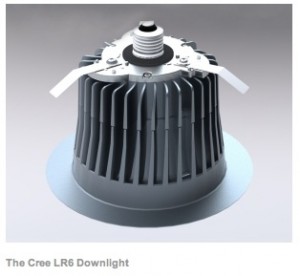 Lighting can account for 5%-15% of a home’s total energy use. Being one of the first to install the new LED (light-emitting diode) recessed can fixtures made by CREE, we were pioneers in this area. The fixtures we chose, LR6 recessed downlights, had just come on the market. They are rated at 12 watts for 673 lumens and are projected to last 35,000 hours (though the website says 50,000, I am going with the Energy Star rating of 35,000 hours). When I plugged the fixture into my Watt Meter, though, the reading was a only 6 watts! The light output compares to a 60-watt incandescent (regular) bulb, or a 14-watt CFL (compact fluorescent light) bulb, which have lifetimes of up to 1,000 hours and 15,000 hours, respectively. The LED recessed can light is more diffused than spot lighting, but I like that; it is also dimmable. Another benefit is that they do not give off any heat, thereby reducing the risk of snow melt and ice dams in between the roof and the ceiling. And, unlike CFLs, they do not contain any mercury. If it were up to me, all the legislation around CFLs would be immediately replaced by LEDs — leapfrogging CFL technology completely.
Lighting can account for 5%-15% of a home’s total energy use. Being one of the first to install the new LED (light-emitting diode) recessed can fixtures made by CREE, we were pioneers in this area. The fixtures we chose, LR6 recessed downlights, had just come on the market. They are rated at 12 watts for 673 lumens and are projected to last 35,000 hours (though the website says 50,000, I am going with the Energy Star rating of 35,000 hours). When I plugged the fixture into my Watt Meter, though, the reading was a only 6 watts! The light output compares to a 60-watt incandescent (regular) bulb, or a 14-watt CFL (compact fluorescent light) bulb, which have lifetimes of up to 1,000 hours and 15,000 hours, respectively. The LED recessed can light is more diffused than spot lighting, but I like that; it is also dimmable. Another benefit is that they do not give off any heat, thereby reducing the risk of snow melt and ice dams in between the roof and the ceiling. And, unlike CFLs, they do not contain any mercury. If it were up to me, all the legislation around CFLs would be immediately replaced by LEDs — leapfrogging CFL technology completely.
Did the LED cans cost more? Of course they did. While the large price tag of $143.75 cost per can was 20%-30% more than our choice of incandescent cans, the price has been going down steadily since we purchased them. And, if they do last 35,000 hours, that’s really about 20 years (assuming they are on 5 hours per day)! The energy savings amounts to about $10 per year per can; so if we paid $30 more per can, that’s a 3-year payback, not including any bulb replacement costs. It was well worth it, regardless of the LEED points.
Yes…getting back to the point — LEED points. The prerequisite for this section is as follows:
8.1 ENERGY STAR Lights. Install at least four ENERGY STAR labeled light fixtures or ENERGY STAR labeled compact fluorescent light bulbs in high-use rooms (kitchen, dining room, living room, family room, hallways).
This seems odd to me. We could have an entirely inefficient lighting package, then go for LEED, and all we would have to do would be to add four more fixtures or CFL bulbs in a common area. What if you lived in a small little studio and you only needed two fixtures? It seems like the overall percentage would be more important than the number. Anyway, all of our LED lights are Energy Star labeled, and we have way more than 4, and they are all over our high-use rooms, so we meet the prerequisite.
I will skip 8.2 Improved Lighting (which allows for 1.5 points maximum) and go directly to 8.3 Advance Lighting Package for 3 points, because I think we’ve earned it. (Also, in 8.2 (b), there is a requirement that all outdoor lighting must have either motion sensor controls or integrated photovoltaic cells. We don’t have those.)
This portion requires that we install at least 60% ENERGY STAR qualified hard-wired fixtures and 100% ENERGY STAR-qualified ceiling fans (if any). OR, we need to install ENERGY STAR labeled lamps in at least 80% of the fixtures throughout the home. Since we have almost no lamps and all hardwired fixtures, we need to meet the first part — 60%. I am happy to see the Cree LR6s on the list of Energy Star Qualified LED lighting. I went around and counted all of our LED cans and the rest of our fixtures, which are mostly FLOS Gl0-balls that dim down to look like moons floating in the sky (but are not Energy Star qualified). By my calculations, 82% of all of our indoor fixtures are the LED lights. If you include all outdoor fixtures as well (we have some LED cans in a cantilever outside), we are at 75%. Looks like we would get the three points if we were taking the prescriptive pathway.
EA Prescriptive Path points so far: 15
